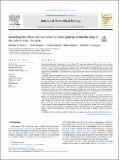Files in this item
Modelling the effects of environmental heterogeneity within the lung on the tuberculosis life-cycle
Item metadata
| dc.contributor.author | Pitcher, Michael John | |
| dc.contributor.author | Bowness, Ruth | |
| dc.contributor.author | Dobson, Simon Andrew | |
| dc.contributor.author | Eftimie, Raluca | |
| dc.contributor.author | Gillespie, Stephen Henry | |
| dc.date.accessioned | 2020-09-09T15:30:07Z | |
| dc.date.available | 2020-09-09T15:30:07Z | |
| dc.date.issued | 2020-12-07 | |
| dc.identifier | 269148559 | |
| dc.identifier | 59412098-18f9-4883-a6f3-a3fbfbe60eb4 | |
| dc.identifier | 85089281542 | |
| dc.identifier | 000563508700003 | |
| dc.identifier.citation | Pitcher , M J , Bowness , R , Dobson , S A , Eftimie , R & Gillespie , S H 2020 , ' Modelling the effects of environmental heterogeneity within the lung on the tuberculosis life-cycle ' , Journal of Theoretical Biology , vol. 506 , 110381 . https://doi.org/10.1016/j.jtbi.2020.110381 | en |
| dc.identifier.issn | 0022-5193 | |
| dc.identifier.other | ORCID: /0000-0002-4090-5168/work/78528000 | |
| dc.identifier.other | ORCID: /0000-0001-6537-7712/work/78528008 | |
| dc.identifier.other | ORCID: /0000-0001-9633-2103/work/78528505 | |
| dc.identifier.uri | https://hdl.handle.net/10023/20596 | |
| dc.description | Funding: This work was supported by the Medical Research Council [grant number MR/P014704/1] and the PreDiCT-TB consortium (IMI Joint undertaking grant agreement number 115337, resources of which are composed of financial contribution from the European Union’s Seventh Framework Programme (FP7/2007-2013) and EF-PIA companies’ in kind contribution. | en |
| dc.description.abstract | Progress in shortening the duration of tuberculosis (TB) treatment is hampered by the lack of a predictive model that accurately reflects the diverse environment within the lung. This is important as TB has been shown to produce distinct localisations to different areas of the lung during different disease stages, with the environmental heterogeneity within the lung of factors such as air ventilation, blood perfusion and oxygen tension believed to contribute to the apical localisation witnessed during the post-primary form of the disease. Building upon our previous model of environmental lung heterogeneity, we present a networked metapopulation model that simulates TB across the whole lung, incorporating these notions of environmental heterogeneity across the whole TB life-cycle to show how different stages of the disease are influenced by different environmental and immunological factors. The alveolar tissue in the lung is divided into distinct patches, with each patch representing a portion of the total tissue and containing environmental attributes that reflect the internal conditions at that location. We include populations of bacteria and immune cells in various states, and events are included which determine how the members of the model interact with each other and the environment. By allowing some of these events to be dependent on environmental attributes, we create a set of heterogeneous dynamics, whereby the location of the tissue within the lung determines the disease pathological events that occur there. Our results show that the environmental heterogeneity within the lung is a plausible driving force behind the apical localisation during post-primary disease. After initial infection, bacterial levels will grow in the initial infection location at the base of the lung until an adaptive immune response is initiated. During this period, bacteria are able to disseminate and create new lesions throughout the lung. During the latent stage, the lesions that are situated towards the apex are the largest in size, and once a post-primary immune-suppressing event occurs, it is the uppermost lesions that reach the highest levels of bacterial proliferation. Our sensitivity analysis also shows that it is the differential in blood perfusion, causing reduced immune activity towards the apex, which has the biggest influence of disease outputs. | |
| dc.format.extent | 18 | |
| dc.format.extent | 3455427 | |
| dc.language.iso | eng | |
| dc.relation.ispartof | Journal of Theoretical Biology | en |
| dc.subject | Tuberculosis | en |
| dc.subject | Computational biology | en |
| dc.subject | Within-host model | en |
| dc.subject | Bacteria | en |
| dc.subject | Metapopulation | en |
| dc.subject | Lung | en |
| dc.subject | Localisation | en |
| dc.subject | RA0421 Public health. Hygiene. Preventive Medicine | en |
| dc.subject | QA75 Electronic computers. Computer science | en |
| dc.subject | DAS | en |
| dc.subject | SDG 3 - Good Health and Well-being | en |
| dc.subject.lcc | RA0421 | en |
| dc.subject.lcc | QA75 | en |
| dc.title | Modelling the effects of environmental heterogeneity within the lung on the tuberculosis life-cycle | en |
| dc.type | Journal article | en |
| dc.contributor.sponsor | European Commission | en |
| dc.contributor.sponsor | Medical Research Council | en |
| dc.contributor.institution | University of St Andrews. Sir James Mackenzie Institute for Early Diagnosis | en |
| dc.contributor.institution | University of St Andrews. School of Computer Science | en |
| dc.contributor.institution | University of St Andrews. Centre for Biophotonics | en |
| dc.contributor.institution | University of St Andrews. Infection and Global Health Division | en |
| dc.contributor.institution | University of St Andrews. Global Health Implementation Group | en |
| dc.contributor.institution | University of St Andrews. Gillespie Group | en |
| dc.contributor.institution | University of St Andrews. Infection Group | en |
| dc.contributor.institution | University of St Andrews. Biomedical Sciences Research Complex | en |
| dc.contributor.institution | University of St Andrews. School of Medicine | en |
| dc.identifier.doi | 10.1016/j.jtbi.2020.110381 | |
| dc.description.status | Peer reviewed | en |
| dc.identifier.url | https://www.biorxiv.org/content/10.1101/2019.12.12.871269v1 | en |
| dc.identifier.grantnumber | en | |
| dc.identifier.grantnumber | MR/P014704/1 | en |
This item appears in the following Collection(s)
Items in the St Andrews Research Repository are protected by copyright, with all rights reserved, unless otherwise indicated.

